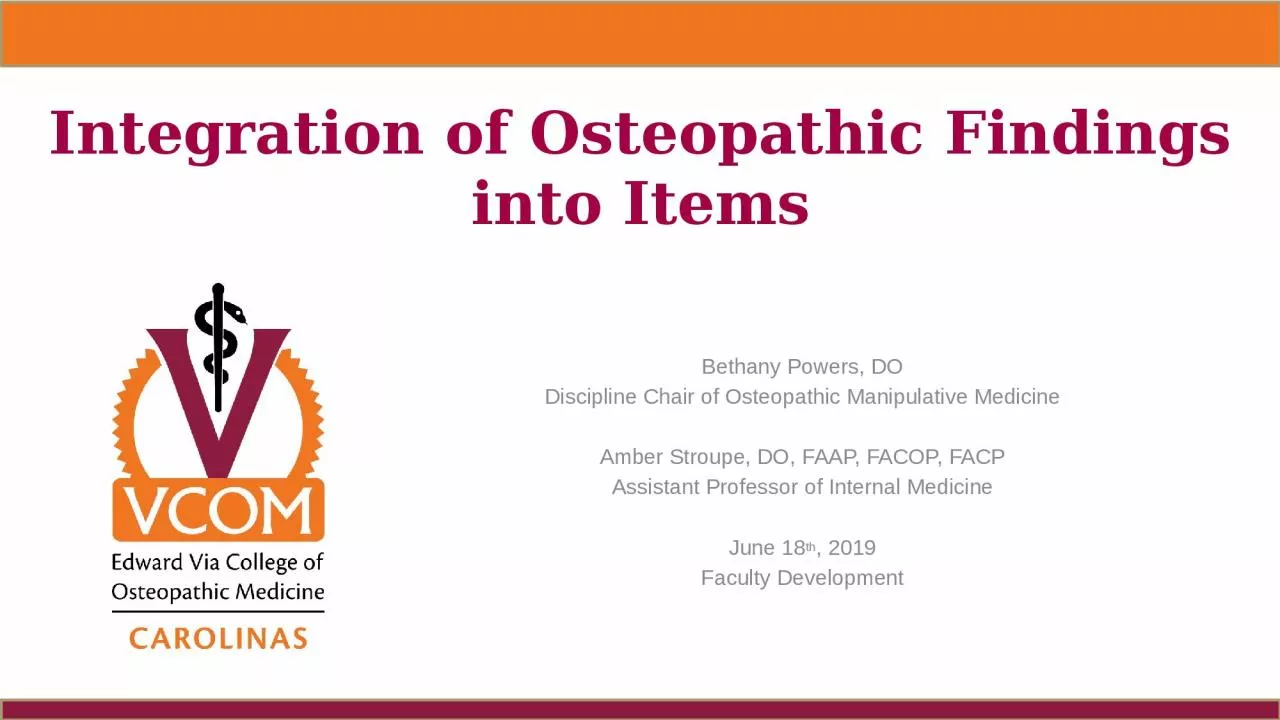

Bethany Powers DO Discipline Chair of Osteopathic Manipulative Medicine Amber Stroupe DO FAAP FACOP FACP Assistant Professor of Internal Medicine June 18 th 2019 Faculty Development Objectives ID: 934398
Download Presentation The PPT/PDF document "Integratio n of Osteopathic Findings int..." is the property of its rightful owner. Permission is granted to download and print the materials on this web site for personal, non-commercial use only, and to display it on your personal computer provided you do not modify the materials and that you retain all copyright notices contained in the materials. By downloading content from our website, you accept the terms of this agreement.
Slide1
Integration of Osteopathic Findings into Items
Bethany Powers, DODiscipline Chair of Osteopathic Manipulative MedicineAmber Stroupe, DO, FAAP, FACOP, FACPAssistant Professor of Internal MedicineJune 18th, 2019Faculty Development
Slide2Objectives
Recognize components of the osteopathic structural examination.Identify recent osteopathic research studies.Incorporate osteopathic examination findings into item writing.
Slide3Facilitators
Rebecca Bowers, DOLisa Carroll, MDBethany Powers, DOAmber Stroupe, DO
Slide4Item Example #1
A 22-year-old male marathon runner presents to the office with complaint of right-sided rib pain when he runs long distances. Physical examination reveals normal heart and lung findings and an exhalation dysfunction at ribs 4-5 on the right. Which of the following muscles or muscle groups will be most useful in correcting this dysfunction utilizing a direct method?Anterior scaleneLatissimus dorsiPectoralis minor*
Quadratus lumborumSerratus anterior
Practice Exam COMLEX-USA Level 1
Slide5Item Example #2
A 1-day-old male is evaluated for failure to breast feed. Physical examination reveals poor coordination of lip and tongue motion, generalized hypotonia, bilateral condylar compression, a hand anomaly as shown in the exhibit, and marked inferior vertical strain. As this neonate grows, his facial anomalies will become more pronounced due to:Abnormal blood cell growth in the bone marrowHypoplasia of the midline facial bones*
Lack of cartilaginous growth platesPoor brain growth
Premature closure of fontanelles
Practice Exam COMLEX-USA Level 1
Slide6Item Example #3
A 55-year-old male presents to the emergency department with a 2-day history of severe epigastric pain and vomiting. Past medical history is negative for any similar episodes. He does not take any medications. He smokes cigarettes, has a 40 pack-year history, and consumes more than 8 cans of beer per day. Abdominal examination reveals epigastric tenderness. Laboratory studies reveal a serum amylase level of 467 U/L (reference range: 28-100 U/L) and a γ-glutamyltransferase level of 212 U/L (reference range: <55 U/L). Referred pain in this patient is transmitted to the spinal cord by which of the following nerves?
Anterior rami of T1-T5Anterior rami of T6-T10*Anterior rami of T11-T12
Posterior rami of T1-T5Posterior rami of T6-T10Posterior rami of T11-T12
Practice Exam COMLEX-USA Level 1
Slide7Item Example #4
A 22-year-old female is admitted to the hospital with a 2-day history of increased frequency of bowel movements with bloody stools and worsening abdominal cramping. She also complains of weakness. Past medical history reveals Crohn disease. Physical examination reveals:C2 flexed, rotated left, sidebent leftT3 extended, rotated right, sidebent rightTenderness at the insertion of the left iliolumbar ligamentMotion restriction at the left sacroiliac jointFascial tension over the super mesenteric ganglion
The somatic dysfunction at which site is most likely the result of increased sympathetic activity?C2
Iliolumbar ligamentSacroiliac jointSuperior mesenteric ganglion*T3
Practice Exam COMLEX-USA Level 1
Slide8Item Example #5
A 25-year-old female presents to the office with a 3-day history of dysuria, urinary frequency, and foul-smelling urine. She denies fever, nausea, and vomiting. She has no prior history of similar symptoms. Vital signs reveal a temperature of 36.8⁰C (98.2⁰F), blood pressure 110/70 mmHg, heart rate 78/min, and respiratory rate 16/min. Physical examination reveals a soft abdomen with active bowel sounds and no indirect or rebound tenderness. She has mild to moderate tenderness over the bladder, the right pubic ramus, and the sacrotuberous ligament. There is restriction of sacral motion with sacral rocking. There is no pain with percussion over the costovertebral angles bilaterally. A urine dipstick is positive for leukocytes, hemolyzed blood, nitrites, and leukocyte esterase. A pregnancy test is negative. In addition to oral antibiotic therapy, the most appropriate next step is:
Admission to the hospital for intravenous fluidsCT scan of the abdomen and pelvis
Osteopathic manipulative treatment*Referral to a urologist for cystoscopyUltrasonography of the kidneys and ureters
Practice Exam COMLEX-USA Level 2-CE
Slide9References
COMLEX-USA Level 1 Practice Exam: https://nbomeapp.nbome.org/pls/apex_prod/f?p=301:5:16770891652683:::5::COMLEX-USA Level 2-CE Practice Exam: https://nbomeapp.nbome.org/pls/apex_prod/f?p=301:5:473036973674:::5::